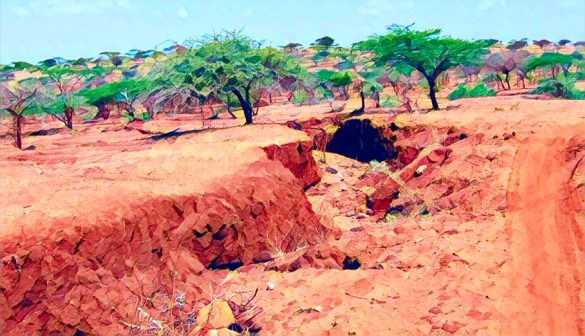KEY POINTS
- Zimbabwe’s farmlands face severe degradation due to deforestation, erosion, and overgrazing.
- Agroforestry, conservation agriculture, and reforestation are key restoration strategies.
- Community engagement and international support are essential for scalable solutions.
Zimbabwe, once regarded as the “breadbasket of Africa,” has faced significant challenges in maintaining its agricultural productivity.
Among these is the widespread degradation of farmland, caused by factors such as overgrazing, deforestation, soil erosion, and unsustainable farming practices.
As more and more land continues to be degraded and agricultural yields continue to decline due to food insecurity, it has become important for the country to rehabilitate degraded land.
Emergency measures to rehabilitate farmlands in Zimbabwe not only signal hope in the revival of activity but also in uplifting livelihoods coupled with the restoration of the land.
The Scale of Land Degradation in Zimbabwe
Land degradation is a major problem in Zimbabwe and estimates suggest that 30 percent of Agricultural land is under threat. It has contributed to the deterioration of the soil by receiving materials that reduced soil fertility, constraints of production resulting in poor yields, and frequent attacks by droughts.
Land degradation is caused by several factors of which deforestation is a major factor. In the rural setting firewood is chopped from trees or land is cleared for farming and other agricultural activities.
Overgrazing especially in communal lands worsens the problem by removing vegetation cover hence exposing more ground to be covered by sand.
Due to irrigation, in some places, the provided methods have been improper, which has led to the formation of salts on the working land thus making the soil to be unfit for cultivation.
Strategies for Land Restoration
To combat land degradation, Zimbabwe has embraced several innovative and sustainable strategies:
Agroforestry
Techniques of growing trees and shrubs along with crops is a practice that has received much consideration in Zimbabwe today. It also goes to the extent of minimizing risks of soil erosion, boosting fertility, and also increasing water holding capacity. Organizations like the Food and Agriculture Organization (FAO) have long been advocating for agroforestry as a tool to reclaim degraded lands and raise the productivity of farming systems.
Conservation agriculture
Conservation agriculture, thus entails minimum tillage, use of rotations, and cover crops. They also facilitate the reconstruction of the shape and aggregation of the soil, its water-holding capacity, and the level of its organic resources.
However, it is now encouraging to note that there are one or two non-governmental organizations such as CARE International that have implemented different Conservation agriculture projects that yielded positive results and have assisted in enhancing the yields of some of the soils in the arid areas in Zimbabwe.
Reforestation and afforestation
Tree planting is responding to the loss of tree cover in degraded land. Community-led initiatives like planting indigenous trees not only restore the ecosystem but also provide income opportunities through the sale of tree products like fruits and timber. Some of the reforestation programs in Zimbabwe have been funded through the United Nations Development Program (UNDP).
Measures in soil and water conservation
Contour farming, designing of terraces, and check dams are examples of the measures being used to minimize water runoff hence soil erosion. These methods have been proven to work in the semi-arid region of Masvingo where fluctuation in rainfall increases rates of land degradation.
Challenges and opportunities
However there is still a number of challenges in the process of land restoration in Zimbabwe. Lack of funding and lack of capacity of professionals impede the expansion of plans for restoration.
However, weak land rights also put some farmers off practicing long-term restoration because of insecurity of tenure.
Nevertheless, there are numerous advantages to trying to recover the degraded lands. There is evidence that rehabilitation of the farmlands leads to high crop yields, food security, and climate change impact..
In addition, the life-space of restored lands has the ability to enhance species distribution, the ecological system, and habitation for wild animals. Challenges can only be tackled and the process of restoration scaled up through involving communities and using public and private partnership.
The path forward
The restoration of degraded farmland in Zimbabwe involves not only modern techniques but also the adoption of the local preference, and effective policies.
This is especially important as long-term engagement of the community requires improvement of their participation as well as providing them with necessary resources and training. Besides, the use of international funding and collaboration can help source the kind of funding and technical assistance that is required to rehabilitate large-scale farmland.
Indeed, the agricultural potential that made Zimbabwe previously known as the breadbasket of Africa can still be realized. Therefore, recognising the need to reclaim its lost land, the country should embark on land management practices that would support food production, improve the welfare of the rural population, and support the international fight against climate change.


